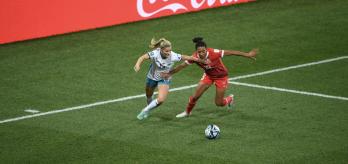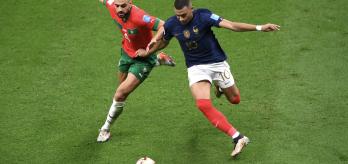Key points
-
Teams covered less ground overall in the second half than in the first period, but the distances covered at higher intensities were maintained across halves.
-
Players in all positions reduced their total distance in the second half, but centre-backs, central midfielders and wide forwards maintained or even increased their high-intensity and sprinting performances after the half-time interval.
-
Greater importance should be placed on preparing teams and players in all positions for longer games with equal intensity across halves.
Work-rate distribution across halves
Research has reported that elite female players cover less distance both in total and in selected speed zones after half-time than in the first half of matches.1 Thus, the intense, intermittent nature of women’s football may cause some degree of fatigue towards the end of games.2 A multitude of mechanisms have been proposed to explain fatigue development in football, but researchers have failed to identify its precise cause.3 Some have attributed match-induced fatigue to depleted muscle glycogen stores at the end of a match and reduced phosphocreatine availability after intense periods.4 However, football is a complex sport and second-half performance declines are impacted by more than just fatigue. For instance, match importance and the changing game state are among the many factors that can decrease or increase a player’s physical output.5
New rules modify half-by-half trends
Another aspect to consider is the introduction of new rules. For instance, FIFA’s new directive regarding added time has resulted in much longer games and particularly second halves. The latest rules also allowed teams to make five substitutions at the FIFA Women’s World Cup Australia & New Zealand 2023™, compared to just three at the 2015 and 2019 in Canada and France respectively. Thus, half-by-half trends across teams and positions need to be quantified to establish whether work-rate distribution has changed due to modified rules.
Optimising half-by-half comparisons
Previous research examining half-by-half trends has been based on matches with halves of a reasonably similar duration.1 However, at the FIFA Women’s World Cup 2023™, the second periods of games were much longer than the first halves. Thus, to enable more appropriate comparisons to be made regarding the drop-off in output after half-time, the physical data was adjusted to metres covered per minute of match play (m/min).
Half-by-half team trends
Figures 1-3 display the first- and second-half physical performances of all nations that competed at the FIFA Women’s World Cup 2023. Teams that fall on the centre line covered the same distance in the first and second halves. Teams in the bottom triangle covered more distance in the first half, while teams in the top triangle covered more ground in the second period. Figure 1 shows that teams covered around 6% less total distance in the second half than before the half-time interval on a per-minute basis. Germany and China PR demonstrated the most pronounced declines in total distance in the second half of matches on a per-minute basis. By contrast, Costa Rica, Vietnam, Jamaica and Argentina were the only nations that covered similar or higher total distances in the second half compared to the first period.
However, Figures 2 and 3 show a completely different picture for the ground covered at higher intensities on a per-minute basis. For instance, high-intensity running (>19.0km/h) and sprint distances (>23.0km/h) were either similar or marginally higher in the second half. Brazil and Canada are striking examples of teams that displayed more intensity in the second half than before half-time. Vietnam and South Africa were the exact opposite, as they demonstrated markedly lower intensity in the second period compared to the first half. A similar reduction in second-half total distance per minute occurred at the 2019 and 2023 editions of the FIFA Women’s World Cup.6However, while high-intensity and sprint distances declined in the second half at France 2019,6 this was not the case at the FIFA Women’s World Cup 2023.
This maintenance of match intensity across halves at Australia & New Zealand 2023 is consistent with the half-by-half team trends found during the FIFA World Cup Qatar 2022™.7 This may in part be related to the use of up to five substitutes in games, which may help sustain the intensity of match play. This trend is logical, as substitutes generally cover greater distances on a per-minute basis and are able to perform at higher intensities compared to players who start the game.8
A clear trend also emerged when dividing teams at the FIFA Women’s World Cup 2023 into “Low” and “High” categories regarding their high-intensity and sprint distances in the first half of matches (>19.0 and >23.0km/h). For instance, “High” teams (which covered >65m/min of high-intensity running or >18m/min of sprinting in the first half) were more likely to reduce their distances in the second half. Brazil were the exception to this rule. Conversely, “Low” teams (which covered <65m/min of high-intensity running or <18m/min of sprinting in the first half) were more likely to increase their distances in the second half. Vietnam were the largest outlier in this regard.
These trends could be due to numerous factors, such as physiological fatigue, teams/players pacing themselves and various tactical and contextual aspects. Interestingly, not only were champions Spain ranked as one of the most physically intense teams at the FIFA Women’s World Cup 2023, but they managed to maintain this extreme intensity across both halves, as can be seen by their placement above/close to the centre line in Figures 2 and 3. The maintenance of high-intensity running and sprint distance probably came at the expense of a more pronounced decline in total ground covered in the second half. This trend could demonstrate a pacing strategy that forgoes low-intensity activity such as walking and jogging (Zones 1 and 2) in an attempt to preserve the ability to complete essential running at higher speeds (Zones 4 and 5).9
HALF-BY-HALF POSITIONAL TRENDS
Second-half decline in total distance across the board, a mixed bag for high-intensity running
Figure 4 demonstrates that players in all positions reduced their total per-minute distance in the second half by around 7% compared to the first period. However, this reduction was most evident for centre-forwards (-7.9%) and least prominent for wide forwards (-4.0%). On the other hand, Figures 5 and 6 reveal that the first- and second-half performances varied significantly across the different positions for the distance covered at higher intensities (>19.0 and >23.0km/h) on a per-minute basis. For instance, second-half declines in high-intensity running and sprint distance were more marked for wide defenders (-6.2% and -15.0%), attacking midfielders (-11.0 % and -15.4%) and centre-forwards (-16.0% and -14.9%). Meanwhile, centre-backs (+4.8% and +8.3%), defensive midfielders (-7.5% and 0%), central midfielders (-1.7% and +8.3%) and wide forwards (+2.5% and +13.6%) illustrated less pronounced second-half declines or, in some cases, maintained a stable performance or even increased their second-half intensity.
As high-intensity actions during elite female games have been found to heavily deplete muscle glycogen stores in Type II fibres,4 these positional trends seem logical. Thus, limited energy availability in the second half could have resulted in more pronounced sprinting declines for those sprinting more overall in FIFA Women’s World Cup 2023 games (e.g. centre-forwards and attacking midfielders). This may also partly explain why players in positions completing less sprinting across games were able to maintain or even increase their second-half sprint performances (e.g. centre-backs and central midfielders).
Wide forwards were the only position to deviate from this trend. Due to the gruelling nature of this role, it could be assumed that wingers possess superior physical capabilities compared with other positions. However, this finding could also be related to wide forwards being more active during the second half of games, as the onus and scope to create attacking opportunities increase. For instance, modern international teams regularly employ compact mid-blocks and this tactic may encourage the opposition to frequently use the space along the flanks – principally via wide attacking players – to create chances from crosses.5
Findings highlight the need for high-intensity training among elite female players
The data in this section demonstrates that the intensity of match play across teams and certain positions was maintained across halves. Thus, greater importance should be placed on high-intensity training methods, not only to prepare teams and selected positions for longer games, but also to enable them to maintain or even, in some cases, increase their intensity in the second half if required. Research indicates that position-specific speed endurance training can overload both the aerobic and anaerobic systems and thus improve a player’s high-intensity capacity.10 This can be achieved with or without the ball using a variety of training drills.11-12
References
-
Bradley PS, Dellal A, Mohr M, Castellano J & Wilkie A. Gender differences in match performance characteristics of soccer players competing in the UEFA Champions League. Human Movement Science. 2014, 33: 159-171.
-
Krustrup P, Zebis M, Jensen JM & Mohr M. Game-Induced Fatigue Patterns in Elite Female Soccer. Journal of Strength and Conditioning Research. 2010, 24(2): 437-41.
-
Mohr M, Krustrup P & Bangsbo J. Fatigue in soccer: a brief review. Journal of Sports Sciences. 2005, 23(6): 593-599.
-
Krustrup P, Mohr M, Nybo L, Draganidis D, Randers MB, Ermidis G, Ørntoft C, Røddik L, Batsilas D, Poulios A, Ørtenblad N, Loules G, Deli CK, Batrakoulis A, Nielsen JL, Jamurtas AZ & Fatouros IG. Muscle metabolism and impaired sprint performance in an elite women’s football game. Scandinavian Journal of Medicine & Science in Sports. 2022, 32(Suppl. 1): 27-38.
-
Bradley PS. ‘Setting the Benchmark’ Part 1: The Contextualised Physical Demands of Positional Roles in the FIFA World Cup Qatar 2022. Biology of Sport. 2024, 41(1): 261–270.
-
FIFA, Physical Analysis of the FIFA Women’s World Cup France 2019™, 2020. Available at: img.fifa.com/image/upload/zijqly4oednqa5gffgaz.pdf. Accessed January 2024.
-
Bradley PS. ‘Setting the Benchmark’ Part 2: Contextualising the Physical Demands of Teams in the FIFA World Cup Qatar 2022. Biology of Sport. 2024, 41(1): 271-278.
-
Bradley PS, Lago-Peñas C & Rey E. Evaluation of the Match Performances of Substitution Players in Elite Soccer. International Journal of Sports Physiology and Performance. 2014, 9: 415-424.
-
Bradley PS & Noakes TD. Match running performance fluctuations in elite soccer: indicative of fatigue, pacing or situational influences? Journal of Sports Sciences. 2013, 31(15): 1627-1638.
-
Ade JD, Drust B, Morgan O & Bradley PS. Physiological characteristics and acute fatigue associated with position-specific speed endurance soccer drills: production vs maintenance training. Science and Medicine in Football. 2020, 5(1): 6-17.
-
Fransson D, Nielsen TS, Olsson K, Christensson T, Bradley PS, Fatouros IG, Krustrup P, Nordsborg NB & Mohr M. Skeletal muscle and performance adaptations to high-intensity training in elite male soccer players: speed endurance runs versus small-sided game training. European Journal of Applied Physiology. 2018, 118(1): 111-121.
-
Ade JD, Harley JA & Bradley PS. Physiological Response, Time-Motion Characteristics, and Reproducibility of Various Speed-Endurance Drills in Elite Youth Soccer Players: Small-Sided Games Versus Generic Running. International Journal of Sports Physiology and Performance. 2014, 9(3): 471-479.













